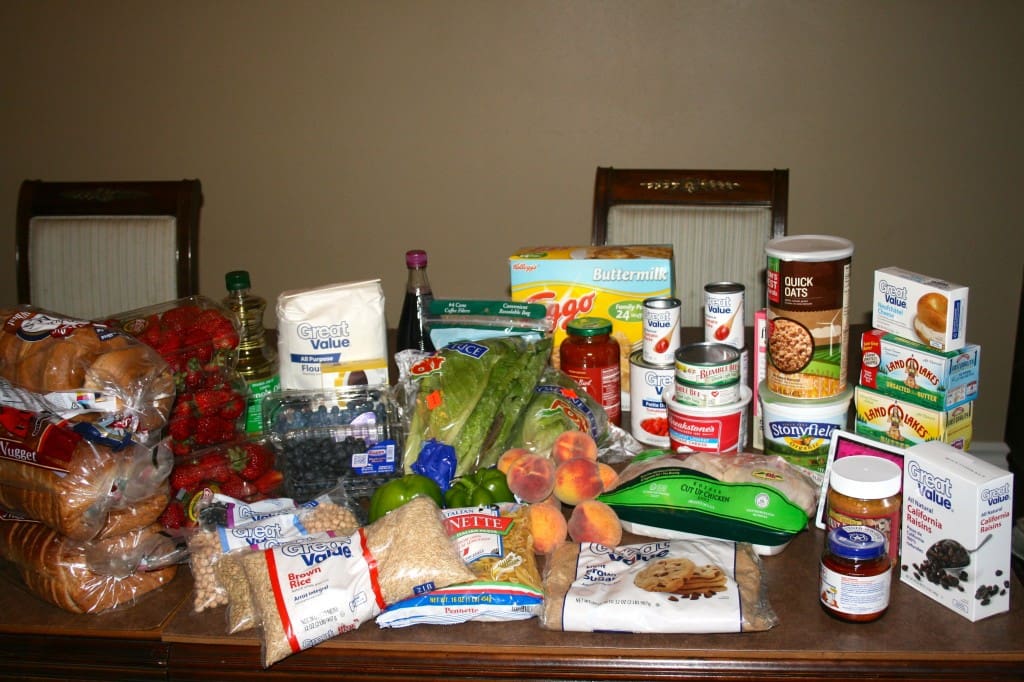Yesterday, I did the second half of my shopping for the SNAP Food Stamp Challenge.
I was going to shop only at Walmart and Costco. But then a friend pointed out that Costco might not take food stamps – and even if they did, the cost of membership ($50) might well be prohibitive.
I called Costco – and found out they do accept the EBT card, but I decided nonetheless not to shop there.
This presented a challenge, since Costco is where I buy all my kosher meat and cheese.With Costco out, I had two options: Trader Joe’s or Hen House (our local grocery store that has a large kosher section, with fresh dairy and a deli counter). I decided to do a combination of the two – since they are right across the street from each other.
I ended up going to Trader Joe’s, Hen House, CVS (which is literally right next to the Hen House – just walked out one door and into the next) for the tuna fish, and then Walmart. That’s a lot of trips – but without Costco, my kosher-keeping menu plan was more complicated.
My grand total for everything you see above was $78.32, before taxes.
This is how it broke down:
Walmart – $44.07
CVS – $.76
Trader Joe’s – $24.61
Hen House – $8.88
TOTAL: $78.32
Together with Friday’s trip to Aldi, I spent $109.37 for this week. I was even able to do a baby bit of “stockpiling”. The butter was on sale for $1.99 per pound. I haven’t seen prices that low in a while – so I picked up three of them!
I’m also pleased that I have some wiggle room so I can afford to pick up any odds and ends that come up during the week.
***
If you are interested in how I put my shopping list together, I followed the following steps:
#1. Made a detailed menu plan – basing it as much as possible on either weekly specials and/or plant-based foods
#2. Made a comprehensive list of everything we need for every item on that menu plan. Since I am participating in the SNAP Challenge, I included things like new flour, new yeast, new oil, etc. The only foods I’m using from home are condiments.
#3. Substituted costly ingredients with less expensive alternatives. For example, one of my recipes calls for maple syrup. I opted for brown sugar instead.
#4. Made a chart that shows how much I anticipate each item will cost, based on my price book. Besides my menu plan, having a reliable price book was invaluable.
#5. Flipped through the circulars, noting sales – and adjust the menu and price estimates as needed.
#6. Filled in a third column in my chart with the name of the store I plan to shop at for each item. When possible, price match, to keep number of stores to a minimum.
#7. Uploaded the shopping lists into Evernote, which I synced with my phone and checked off as I picked up items.
#8. Went shopping sans children, so I could be fully focused on what I was doing. All shopping took me about 90 minutes. It would have been an hour longer (and inevitably more expensive) with the kids.
#9. Was flexible. The Hen House was out of kosher cheese (Kansas City moment), so I made an on-the-spot decision to kill our plan for pizza on Thursday night. Instead, we’ll be having pasta with sauce and sauteed vegetables.
None of my menu plan is based on convenience foods – so I will have to spend a bit more time prepping ingredients/snacks this week. I’ll be sharing a few tips for how I do this over the next few days.
You can also check out my menu plan with shopping list and price estimate chart here in this Google doc.













Leave a Comment